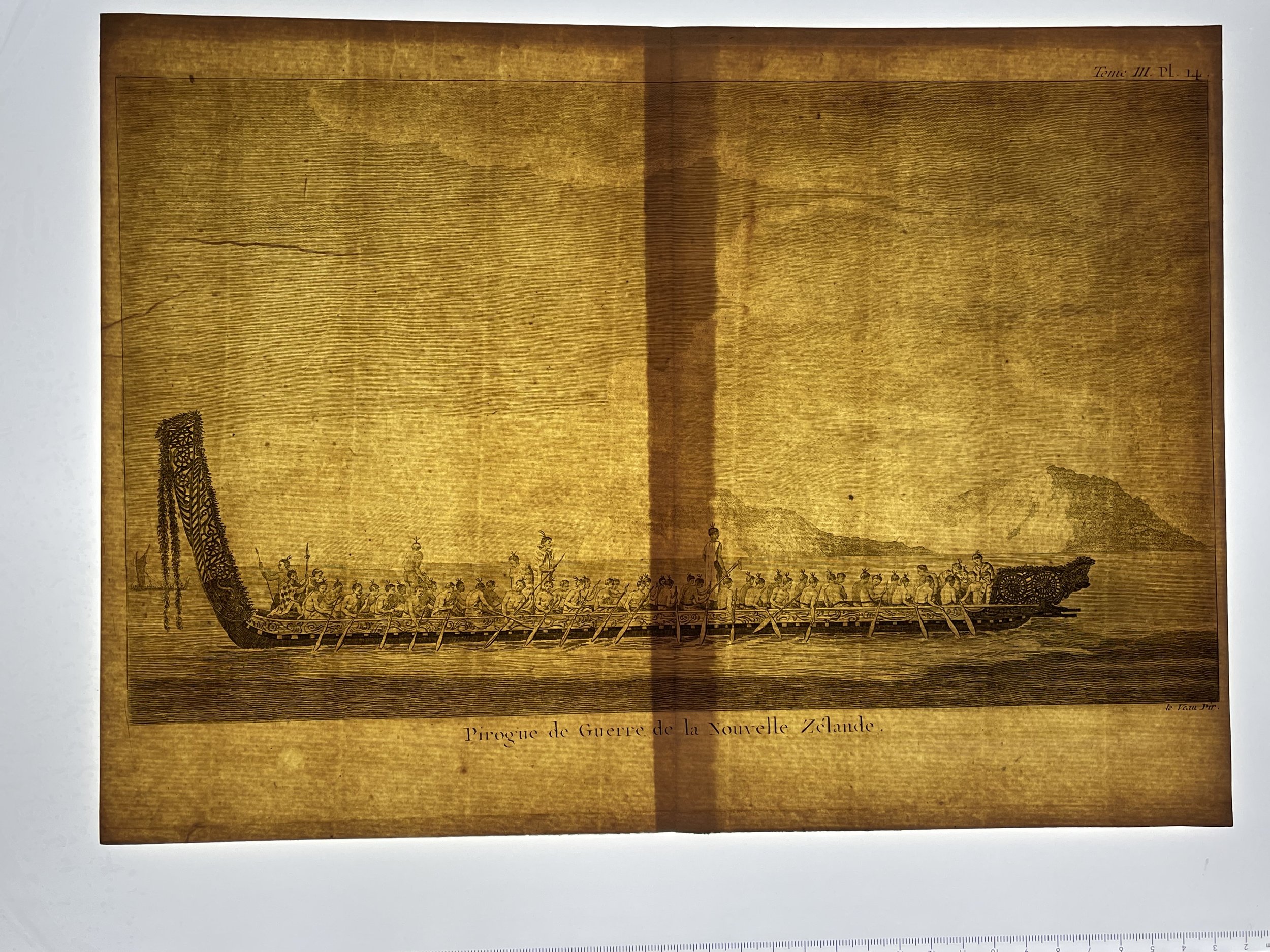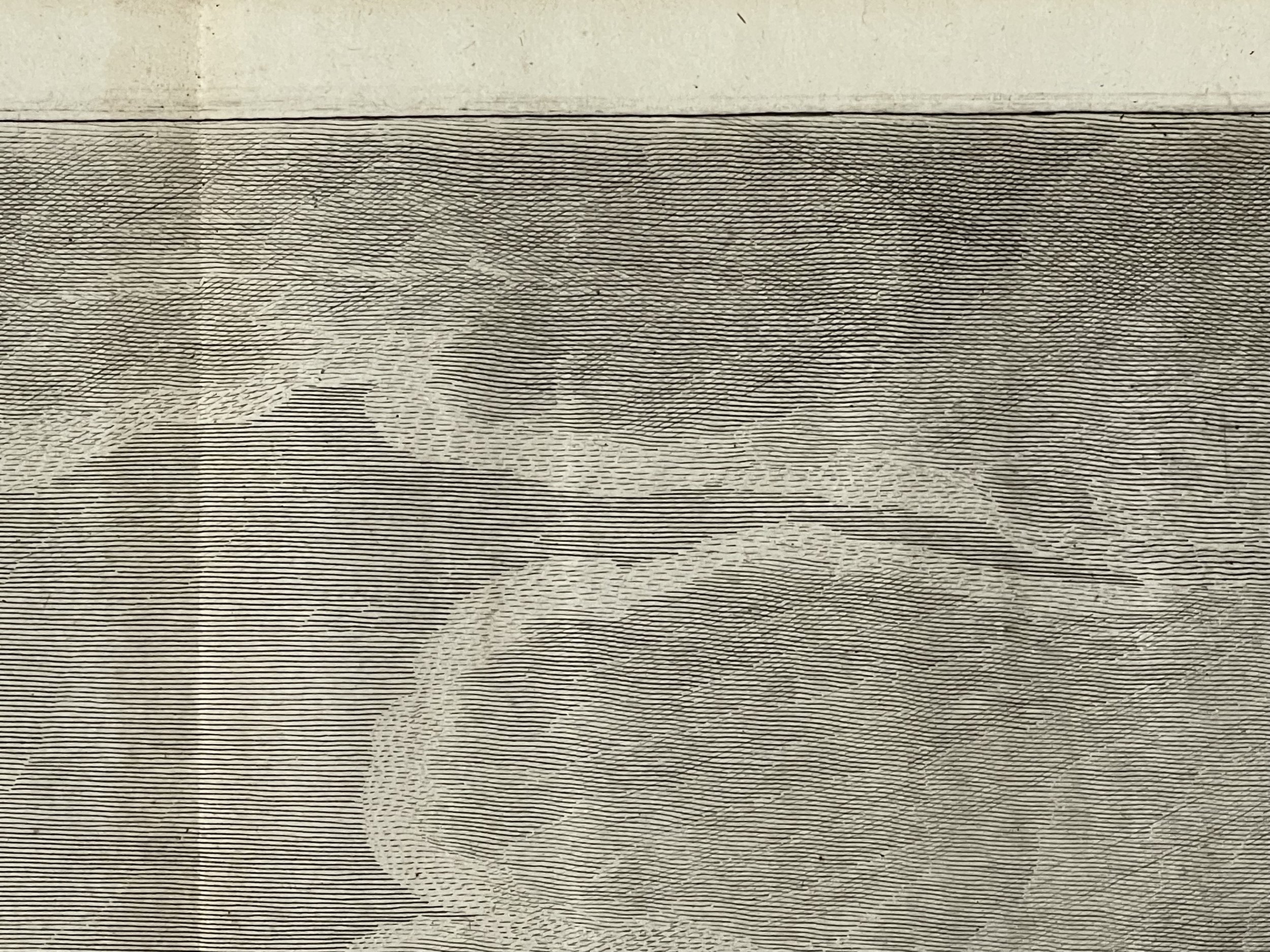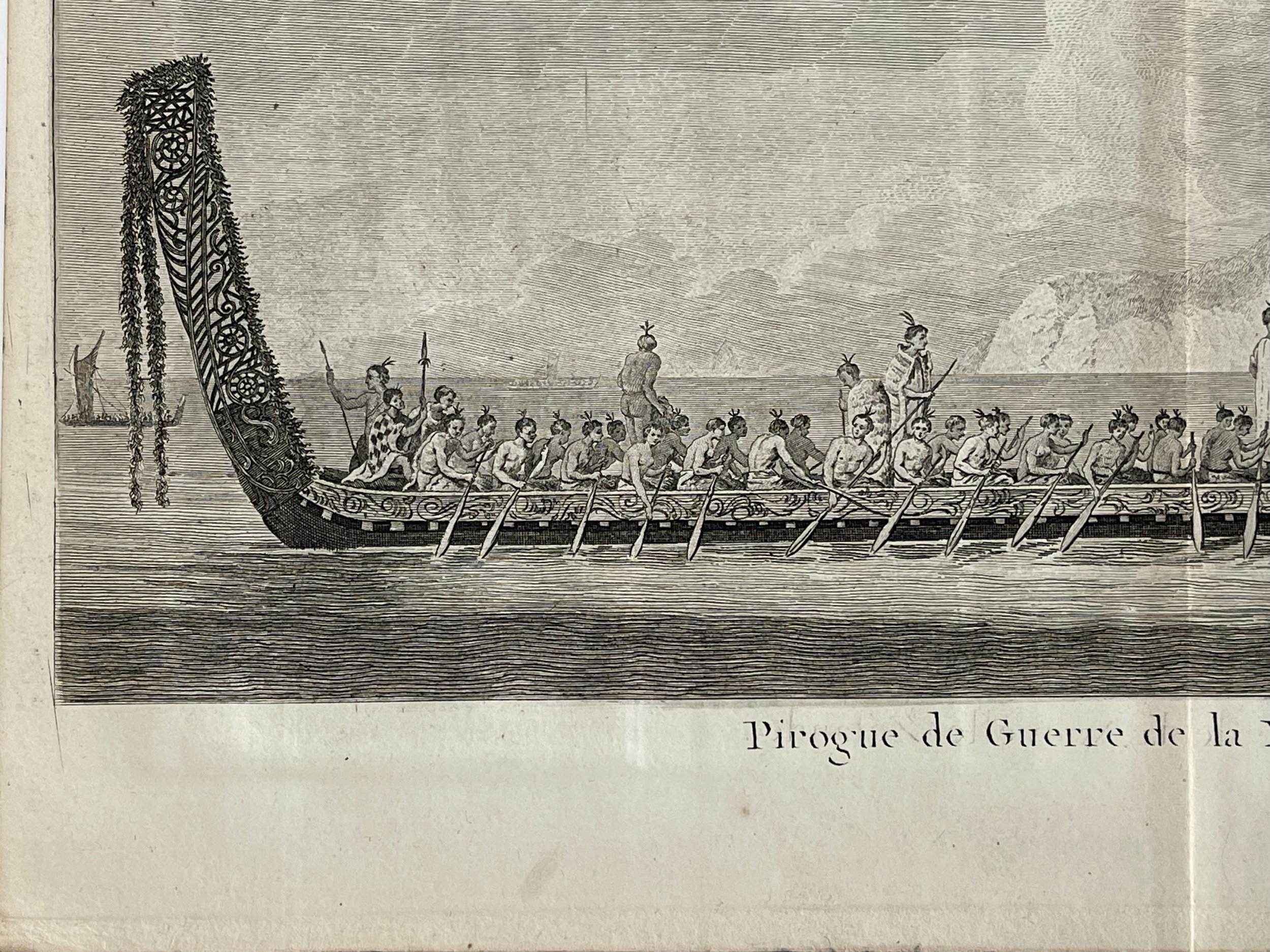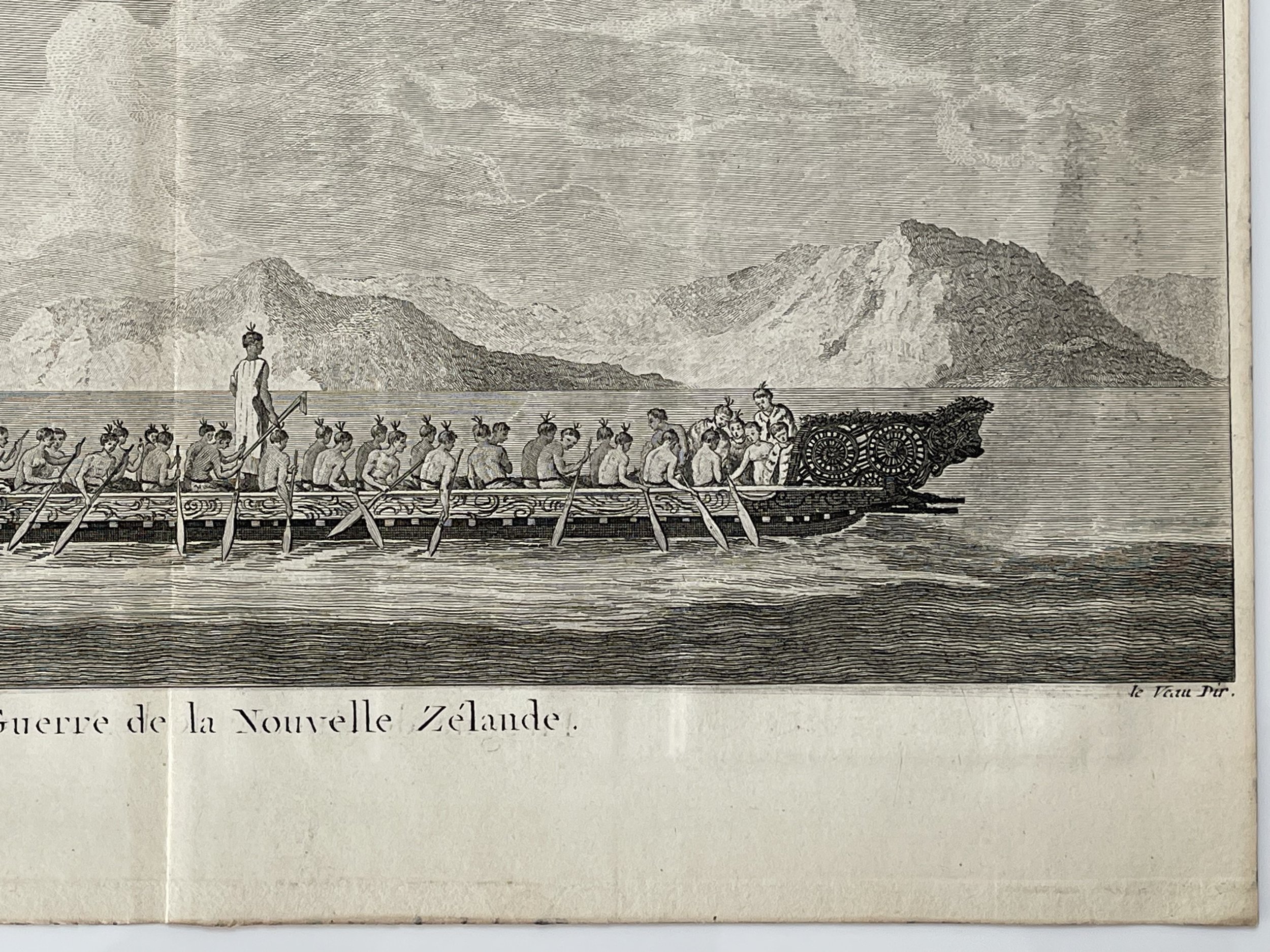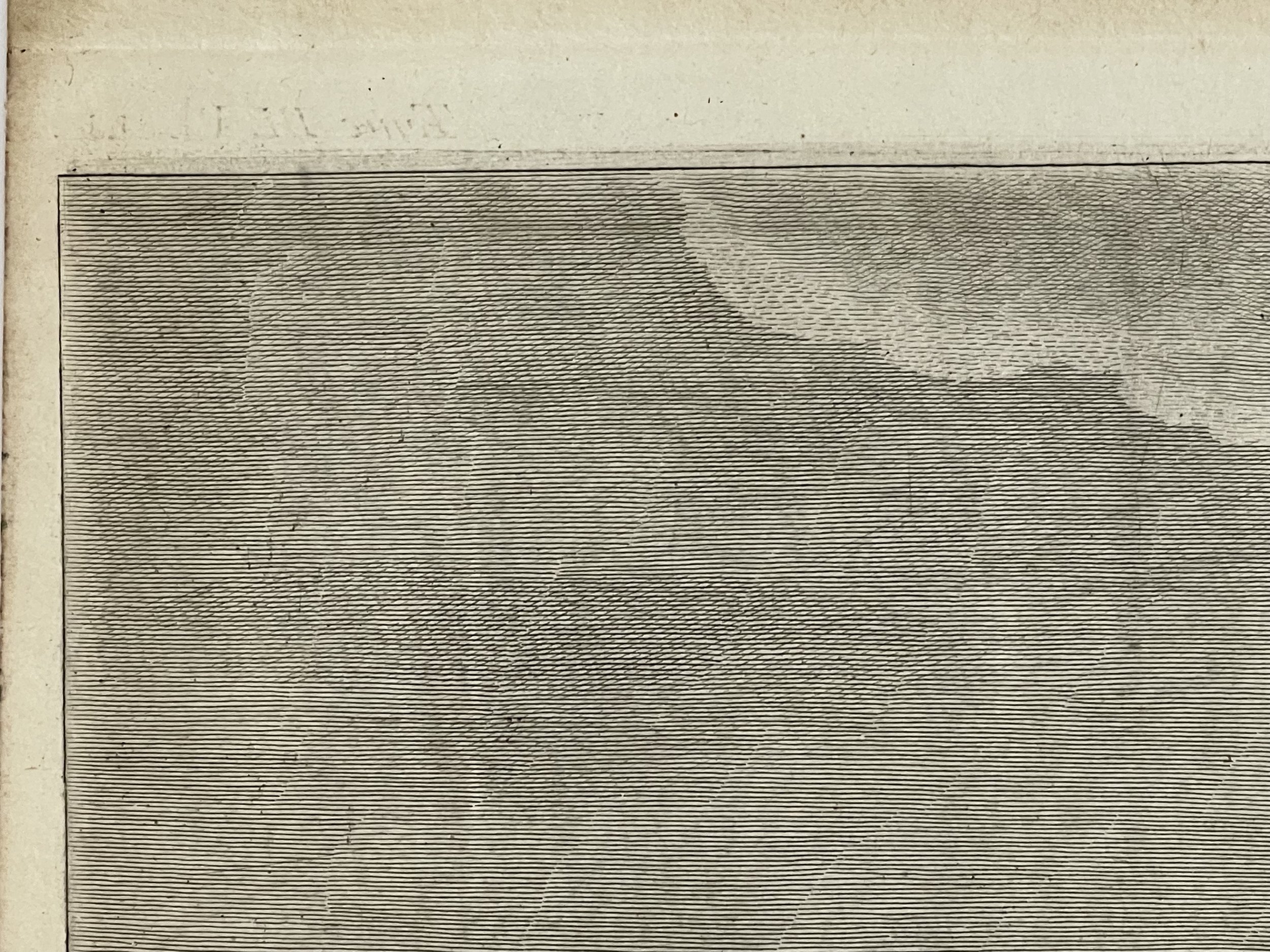Pirogue de Guerre de la Nouvelle Zélande - Sydney Parkinson / Jacques André Le Veau- 1774
Pirogue de Guerre de la Nouvelle Zélande - Captain Cook - Clean image, some foxing, pricing and grading commensurate. Rare.
Sydney Parkinson's famous image of an ornately carved Maori war canoe with high stern on the right, eight occupants standing and about twenty-eight seated. All figures wear feathers in their hair and six are cloaked. Rare engraving from the French edition of the accounts of Cook's first voyage. published (1774) the year after the English edition (1773). The view is engraved by Le Veau.
The title in the English versions was: A War Canoe of New Zealand with a view of Gable End Foreland.
The ingenuity of these people appears in nothing more than than in their canoes: they are long and narrow, and in shape much resemble a New England whale boat: the larger sort seems to be built chiefly for war, and will carry from forty to eighty, or an hundred armed men. We measured one which lay at Tolaga: she was sixty-eight feet and an half long, five feet broad, and three half feet deep; the bottom was sharp, with strait sides like a wedge, and consisted of three lengths, hollowed out about two inches, or an inch and half thick, and well fastened together with strong plaiting: each side consisted of one entire plank, sixty-three feet long, ten or twelve inches broad, and about an inch and quarter thick and these were fitted and lashed to the bottom part with great dexterity and strength.' Hawkesworth I, p.462-464, March 1770.
'During this time, they brandish their spears, hack the air with their patoos and shake their darts as if they meant every moment to begin the attack, singing all the time in a wild but not disagreeable manner and ending every strain with a loud and deep fetchd sigh in which they all join in concert. The whole is accompanied by strokes struck against the sides of the Boats & with their feet, Paddles and arms, the whole in such excellent time that tho the crews of several Canoes join in concert you rarely or never hear a single stroke wrongly placed.
(Banks Journal I|, 29, March 1770.) From Hawkesworth, Relation des Voyages Entrepris par ordre de Sa Majeste Britannique Actuallement Regnante - Reference, Beddie 660, p. 124, Joppien, 1.142B ill.p.201 (English edition)
Sydney Parkinson (1745 - 1771)
Sydney Parkinson was born in Edinburgh, Scotland and from an early age his artistic abilities were noticed. He was employed by Joseph Banks in London before joining him and Daniel Solander on James Cook's Endeavour on a circumnavigation of the globe (1768-1771) as a botanical draughtsman. During the voyage, he made at least 1,300 drawings and paintings. Parkinson was the first European to draw eucalypts. On the return voyage, he died in Batavia.
Jean-Jacques André Le Veau (9 January 1729, Rouen - April 1786, Paris) was a French engraver and designer.
He was born to Jean-Jacques Le Veau, a poor shoemaker, and his wife Marie-Marthe, née Catelin. In poor health, and too much of a burden for his parents, he was entrusted to the care of the nuns of charity at the Hospice de la Madeleine. His artistic talents developed early and were noted by the nuns.
In 1744, he was apprenticed to a maker of passementerie. Two years later, he became a student of Jean-Baptiste Descamps at the free drawing school. In 1748, this was followed by an apprenticeship with a silver engraver. At the same time, thanks to Descamps, he was able to serve as a drawing tutor for young girls from "good families". He was able to do this, despite still being in ill-health which, by then, had been diagnosed as scrofula. Surgery, and a convalescence at the Madeleine Hospice provided some relief.
His first professional engravings, supervised by Descamps, date from this period. Notably, a portrait of Philippe de Champaigne, after Gérard Edelinck. The drawing school awarded him a prize for his work in 1750.
After that, he obtained a position in the workshops of Jacques-Philippe Le Bas, again thanks to the influence of Descamps. His move from Rouen to Paris was financially supported by the families of his students, including Antoine Le Couteulx de Verclives, alderman and future Mayor of Rouen. He would stay with Le Bas for four years, although he was offered 600 Livres a year to stay longer. A brief return to Rouen marked the true beginning of his personal career, when he created four engravings of local landscape scenes, signed with his name.
Upon returning to Paris, he published and sold his engravings, and assisted others with producing their plates. In 1765, he married Marie-Geneviève Deny, the sister of his former students Martial and Jeanne Deny. They had three children. Their eldest, Victoire, would also become an engraver. In 1775, he was admitted to the Académie des Sciences, Belles-lettres et Arts in Rouen.
He was a hard worker, day and night, and most likely died from exhaustion. He was apparently buried in a mass grave at the church of Saint-Benoît-le-Bétourné, which was demolished in 1831 to make room for the Théâtre du Panthéon.
Pirogue de Guerre de la Nouvelle Zélande - Captain Cook - Clean image, some foxing, pricing and grading commensurate. Rare.
Sydney Parkinson's famous image of an ornately carved Maori war canoe with high stern on the right, eight occupants standing and about twenty-eight seated. All figures wear feathers in their hair and six are cloaked. Rare engraving from the French edition of the accounts of Cook's first voyage. published (1774) the year after the English edition (1773). The view is engraved by Le Veau.
The title in the English versions was: A War Canoe of New Zealand with a view of Gable End Foreland.
The ingenuity of these people appears in nothing more than than in their canoes: they are long and narrow, and in shape much resemble a New England whale boat: the larger sort seems to be built chiefly for war, and will carry from forty to eighty, or an hundred armed men. We measured one which lay at Tolaga: she was sixty-eight feet and an half long, five feet broad, and three half feet deep; the bottom was sharp, with strait sides like a wedge, and consisted of three lengths, hollowed out about two inches, or an inch and half thick, and well fastened together with strong plaiting: each side consisted of one entire plank, sixty-three feet long, ten or twelve inches broad, and about an inch and quarter thick and these were fitted and lashed to the bottom part with great dexterity and strength.' Hawkesworth I, p.462-464, March 1770.
'During this time, they brandish their spears, hack the air with their patoos and shake their darts as if they meant every moment to begin the attack, singing all the time in a wild but not disagreeable manner and ending every strain with a loud and deep fetchd sigh in which they all join in concert. The whole is accompanied by strokes struck against the sides of the Boats & with their feet, Paddles and arms, the whole in such excellent time that tho the crews of several Canoes join in concert you rarely or never hear a single stroke wrongly placed.
(Banks Journal I|, 29, March 1770.) From Hawkesworth, Relation des Voyages Entrepris par ordre de Sa Majeste Britannique Actuallement Regnante - Reference, Beddie 660, p. 124, Joppien, 1.142B ill.p.201 (English edition)
Sydney Parkinson (1745 - 1771)
Sydney Parkinson was born in Edinburgh, Scotland and from an early age his artistic abilities were noticed. He was employed by Joseph Banks in London before joining him and Daniel Solander on James Cook's Endeavour on a circumnavigation of the globe (1768-1771) as a botanical draughtsman. During the voyage, he made at least 1,300 drawings and paintings. Parkinson was the first European to draw eucalypts. On the return voyage, he died in Batavia.
Jean-Jacques André Le Veau (9 January 1729, Rouen - April 1786, Paris) was a French engraver and designer.
He was born to Jean-Jacques Le Veau, a poor shoemaker, and his wife Marie-Marthe, née Catelin. In poor health, and too much of a burden for his parents, he was entrusted to the care of the nuns of charity at the Hospice de la Madeleine. His artistic talents developed early and were noted by the nuns.
In 1744, he was apprenticed to a maker of passementerie. Two years later, he became a student of Jean-Baptiste Descamps at the free drawing school. In 1748, this was followed by an apprenticeship with a silver engraver. At the same time, thanks to Descamps, he was able to serve as a drawing tutor for young girls from "good families". He was able to do this, despite still being in ill-health which, by then, had been diagnosed as scrofula. Surgery, and a convalescence at the Madeleine Hospice provided some relief.
His first professional engravings, supervised by Descamps, date from this period. Notably, a portrait of Philippe de Champaigne, after Gérard Edelinck. The drawing school awarded him a prize for his work in 1750.
After that, he obtained a position in the workshops of Jacques-Philippe Le Bas, again thanks to the influence of Descamps. His move from Rouen to Paris was financially supported by the families of his students, including Antoine Le Couteulx de Verclives, alderman and future Mayor of Rouen. He would stay with Le Bas for four years, although he was offered 600 Livres a year to stay longer. A brief return to Rouen marked the true beginning of his personal career, when he created four engravings of local landscape scenes, signed with his name.
Upon returning to Paris, he published and sold his engravings, and assisted others with producing their plates. In 1765, he married Marie-Geneviève Deny, the sister of his former students Martial and Jeanne Deny. They had three children. Their eldest, Victoire, would also become an engraver. In 1775, he was admitted to the Académie des Sciences, Belles-lettres et Arts in Rouen.
He was a hard worker, day and night, and most likely died from exhaustion. He was apparently buried in a mass grave at the church of Saint-Benoît-le-Bétourné, which was demolished in 1831 to make room for the Théâtre du Panthéon.
Pirogue de Guerre de la Nouvelle Zélande - Captain Cook - Clean image, some foxing, pricing and grading commensurate. Rare.
Sydney Parkinson's famous image of an ornately carved Maori war canoe with high stern on the right, eight occupants standing and about twenty-eight seated. All figures wear feathers in their hair and six are cloaked. Rare engraving from the French edition of the accounts of Cook's first voyage. published (1774) the year after the English edition (1773). The view is engraved by Le Veau.
The title in the English versions was: A War Canoe of New Zealand with a view of Gable End Foreland.
The ingenuity of these people appears in nothing more than than in their canoes: they are long and narrow, and in shape much resemble a New England whale boat: the larger sort seems to be built chiefly for war, and will carry from forty to eighty, or an hundred armed men. We measured one which lay at Tolaga: she was sixty-eight feet and an half long, five feet broad, and three half feet deep; the bottom was sharp, with strait sides like a wedge, and consisted of three lengths, hollowed out about two inches, or an inch and half thick, and well fastened together with strong plaiting: each side consisted of one entire plank, sixty-three feet long, ten or twelve inches broad, and about an inch and quarter thick and these were fitted and lashed to the bottom part with great dexterity and strength.' Hawkesworth I, p.462-464, March 1770.
'During this time, they brandish their spears, hack the air with their patoos and shake their darts as if they meant every moment to begin the attack, singing all the time in a wild but not disagreeable manner and ending every strain with a loud and deep fetchd sigh in which they all join in concert. The whole is accompanied by strokes struck against the sides of the Boats & with their feet, Paddles and arms, the whole in such excellent time that tho the crews of several Canoes join in concert you rarely or never hear a single stroke wrongly placed.
(Banks Journal I|, 29, March 1770.) From Hawkesworth, Relation des Voyages Entrepris par ordre de Sa Majeste Britannique Actuallement Regnante - Reference, Beddie 660, p. 124, Joppien, 1.142B ill.p.201 (English edition)
Sydney Parkinson (1745 - 1771)
Sydney Parkinson was born in Edinburgh, Scotland and from an early age his artistic abilities were noticed. He was employed by Joseph Banks in London before joining him and Daniel Solander on James Cook's Endeavour on a circumnavigation of the globe (1768-1771) as a botanical draughtsman. During the voyage, he made at least 1,300 drawings and paintings. Parkinson was the first European to draw eucalypts. On the return voyage, he died in Batavia.
Jean-Jacques André Le Veau (9 January 1729, Rouen - April 1786, Paris) was a French engraver and designer.
He was born to Jean-Jacques Le Veau, a poor shoemaker, and his wife Marie-Marthe, née Catelin. In poor health, and too much of a burden for his parents, he was entrusted to the care of the nuns of charity at the Hospice de la Madeleine. His artistic talents developed early and were noted by the nuns.
In 1744, he was apprenticed to a maker of passementerie. Two years later, he became a student of Jean-Baptiste Descamps at the free drawing school. In 1748, this was followed by an apprenticeship with a silver engraver. At the same time, thanks to Descamps, he was able to serve as a drawing tutor for young girls from "good families". He was able to do this, despite still being in ill-health which, by then, had been diagnosed as scrofula. Surgery, and a convalescence at the Madeleine Hospice provided some relief.
His first professional engravings, supervised by Descamps, date from this period. Notably, a portrait of Philippe de Champaigne, after Gérard Edelinck. The drawing school awarded him a prize for his work in 1750.
After that, he obtained a position in the workshops of Jacques-Philippe Le Bas, again thanks to the influence of Descamps. His move from Rouen to Paris was financially supported by the families of his students, including Antoine Le Couteulx de Verclives, alderman and future Mayor of Rouen. He would stay with Le Bas for four years, although he was offered 600 Livres a year to stay longer. A brief return to Rouen marked the true beginning of his personal career, when he created four engravings of local landscape scenes, signed with his name.
Upon returning to Paris, he published and sold his engravings, and assisted others with producing their plates. In 1765, he married Marie-Geneviève Deny, the sister of his former students Martial and Jeanne Deny. They had three children. Their eldest, Victoire, would also become an engraver. In 1775, he was admitted to the Académie des Sciences, Belles-lettres et Arts in Rouen.
He was a hard worker, day and night, and most likely died from exhaustion. He was apparently buried in a mass grave at the church of Saint-Benoît-le-Bétourné, which was demolished in 1831 to make room for the Théâtre du Panthéon.
Code : A89
Cartographer : Cartographer / Engraver / Publisher: Sydney Parkinson / Jacques André Le Veau
Date : Publication Place / Date - Circa 1774
Size : Sheet size: Image Size: 35 x 25 cm
Availability : Available
Type - Genuine - Antique
Grading A
Where Applicable - Folds as issued. Light box photo shows the folio leaf centre margin hinge ‘glue’, this is not visible otherwise.
Tracked postage, in casement. Please contact me for postal quotation outside of the UK.

